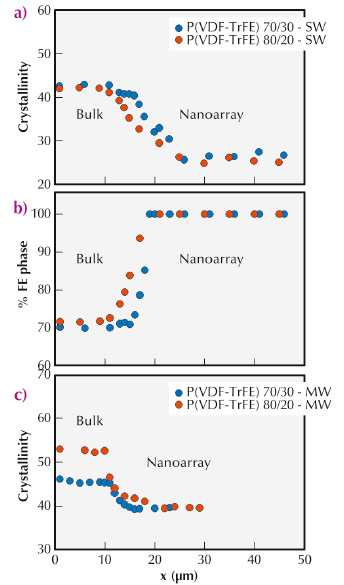- Home
- Users & Science
- Scientific Documentation
- ESRF Highlights
- ESRF Highlights 2013
- Soft condensed matter
- Understanding crystallisation features of polymers under confinement to optimise ferroelectricity in nanostructures
Understanding crystallisation features of polymers under confinement to optimise ferroelectricity in nanostructures
Ferroelectric polymers have emerged as cost-effective functional materials for organic electronic devices due to their high electric breakdown field, low dielectric loss, light weight and high flexibility. Poly(vinylidene fluoride) (PVDF) and its copolymers with trifluoroethylene, P(VDF-TrFE), are ferroelectric polymers with a relatively high remnant polarisation, large piezoelectric coefficient, high dielectric constant, and low dielectric loss. P(VDF-TrFE) thin films and low aspect ratio nanostructures have been extensively studied and used in various dielectric and ferroelectric device applications such as non-volatile organic memories [1] among others. High aspect ratio (length/diameter) one-dimensional (1D) nanostructures are appropriate for studying size-dependent processes with length scales comparable to the nanostructure’s size and may also have greater potential for high density energy storage applications due to the dramatically increased surface area over thin films and low aspect ratio nanostructures.
The phase diagrams and the kinetics of phase transformation processes of matter in confined space can deviate considerably from the respective dependencies observed in bulk. Polymer crystallisation is an example of these phenomena as it is known that a size limitation at the nanometre scale can affect crystal nucleation, growth and orientation. Furthermore, in a previous study concerning PVDF, we reported the crystal phase transition from the a-nonpolar crystal form with chains of an alternating trans–gauche conformation (TGTG) to the γ-ferroelectric crystalline structure with a TTTG sequence, due to PVDF confinement within nanopores [2]. However, the most highly ferroelectric and desired crystalline form is the β-phase, where chains of all-trans (TTTT) conformation exhibit iso-oriented dipoles in a pseudohexagonal crystal packing. P(VDF-TrFE) copolymers crystallise more readily in the β-phase than the homopolymer PVDF because the presence of the third fluorine in the TrFE monomer unit sterically hinders the formation of the TGT conformation.
 |
|
Fig. 78: a) SEM image of the cross-section of a sample infiltrated by solution wetting and fractured in liquid nitrogen. The inset is a magnified image of the interface between the residual polymer film (right) and the nanorod array and alumina membrane (left). b) Schematic diagram of the scanning µ-XRD set-up. |
High aspect ratio 1D nanoarrays of P(VDF-TrFE) copolymers supported by a residual polymer film have been prepared by melt and solution wetting, using porous anodic aluminum oxide (AAO) as a template. X-ray microdiffraction (µ-XRD) experiments were carried out at ID13 to explore the heterogeneities along the 1D nanostructures in order to select the optimum parameters for improving the ferroelectric character of polymer nanoarrays. Scanning µ-XRD with a 1 µm diameter beam was accomplished along the cross-section of the samples (Figure 78).
 |
|
Fig. 79: Spatial evolution, going from the residual polymer film (bulk) towards the nanorod array: a) degree of crystallinity and b) fraction of the ferroelectric form for samples prepared by solution wetting (SW) and c) degree of crystallinity for samples prepared by melt wetting (MW). |
From diffraction patterns collected at regular intervals between the residual polymer film (bulk) and the nanorod array, several structural features such as crystallinity and crystal phase type could be investigated (Figure 79). The evolution of different polymorphs from the mixture of paraelectric and ferroelectric crystal forms (bulk) to the pure ferroelectric form (nanorod array), due to the copolymer confinement within the nanopores of the AAO membrane, was observed for the samples prepared by solution wetting. Samples prepared by melt wetting however exhibited only the ferroelectric phase for both the residual film and nanoarray. The crystal nuclei formed in the residual polymer film connected to the nanoarray play a key role in determining the formation of a gradient crystallinity distribution, where the crystallinity decreases along the first 5-10 micrometres in the nanorods, reaching a steady value afterwards. The above crystallisation features of P(VDF-TrFE) copolymers under confinement indicate potential for optimising the ferroelectric character of polymer nanostructures.
Principal publication and authors
M.C. García-Gutiérrez (a), A. Linares (a), I. Martín-Fabiani (a), J.J. Hernández (b), M. Soccio (a), D.R. Rueda (a), T.A. Ezquerra (a) and M. Reynolds (c), Nanoscale 5, 6006–6012 (2013).
(a) Instituto de Estructura de la Materia (IEM-CSIC), Madrid (Spain)
(b) Institut des Sciences de Matériaux de Mulhouse (France)
(c) ESRF
References
[1] D.E. Martínez-Tong, M. Soccio, M.C. García-Gutiérrez, A. Nogales, D.R. Rueda, N. Alayo, F. Pérez-Murano and T.A. Ezquerra, Appl. Phys. Lett. 102, 191601 (2013).
[2] M.C. García-Gutiérrez, A. Linares, J.J. Hernández, D.R. Rueda, T.A. Ezquerra, P. Poza and R.J. Davies, Nano Lett. 10, 1472–1476 (2010).
Acknowledgements
The authors are grateful for the financial support from the MINECO (grants MAT2011-23455 and FPI BES-2010-030074) and from the CSIC and Fondo Social Europeo (FSE) (JAE-Doc contract), Spain. We thank P. Poza for SEM micrographs and M. Burghammer for his support during measurements at ESRF.



